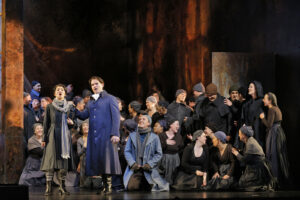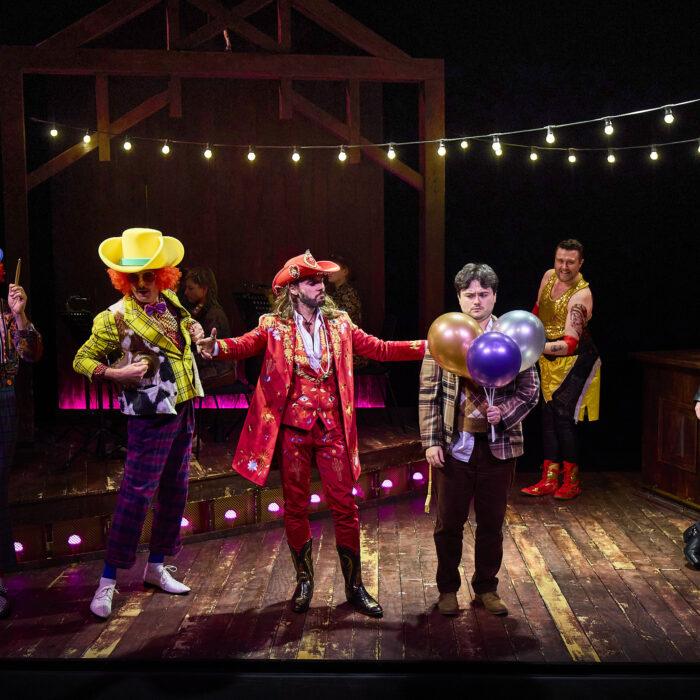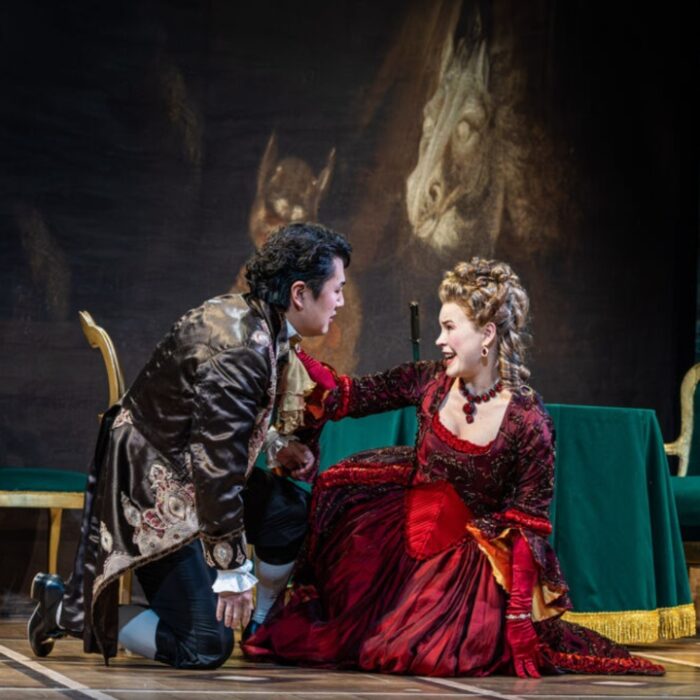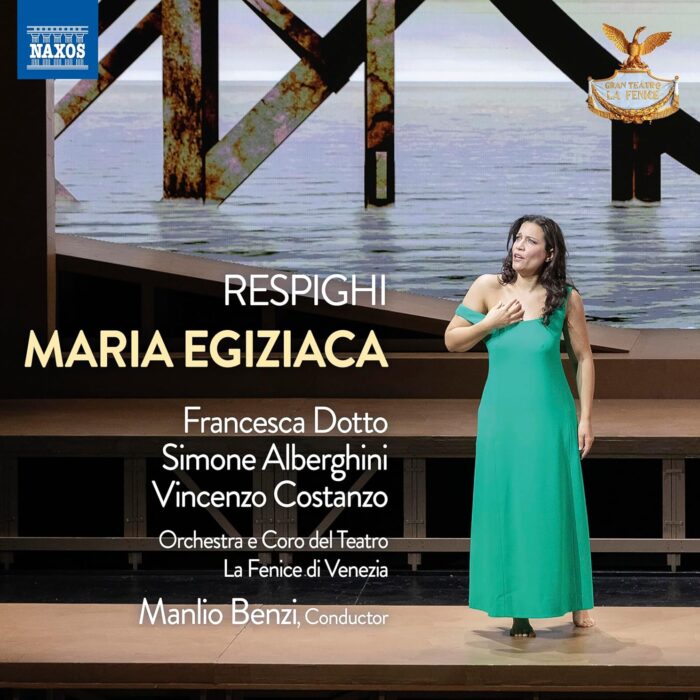
San Francisco Opera 2024-25 Review: Un Ballo in Maschera
By Lois Silverstein(Photo by Cory Weaver)
Festivities galore flooded the San Francisco’s Civic Center Friday night – Opera Ball, Opera Dinner, and the opera itself, Verdi’s, “Un Ballo in Maschera.”
Opening night at San Francisco Opera sparkled with taffeta gowns and tux, platform heels and feathers, jewelry glittering up and down arms and nifty bowties. In honor of the entitled opera and its political intrigue, among ruffles, lace and elaborate collars and cummerbunds, masks, on stage and off, masks, sequined, painted, printed, adorned with feathers and flowers and sparkles in colorful array. Even the great Grand Tier of the War Memorial Opera House, stood festooned with a garland of large linked masks in orchid, magenta, gold, and deep purple. It would all extend further into Golden Gate Park on Sunday with Opera in the Park, with what has become an annual free concert featuring opera cast members.
Director Leo Muscato staged “Un Ballo in Maschera” here in San Francisco, the first production outside of Europe, after he’d done it first for Rome Opera in 2016. His production, set in the original Sweden, after being transposed to Boston during Verdi’s struggles with the censors and producers in the 1850s, was designed by Federica Parolini, and consisted of a rotating stage showing large rooms and even larger couches, mid-stage stairs, drawing rooms, and a study with a portrait gallery. In addition, it had the gypsy-witch-fortune teller Ulrica’s den on a waterfront. In these we witnessed some of the historical events surrounding the colorful King Gustave III of Sweden, two centuries before, and as true with much of Verdi’s “oeuvre”, it aimed to compare those particular events with ours and other eras. Muscato’s creative team used this historical paradigm throughout, imbedding the opera’s political and personal intrigue into it. Silvia Aymonino costume designer, kept the costumes specific to the time frame as well, and Alessandro Verazzi the lights. While these helped to create a unified whole, the opening production lacked some shimmer, no doubt a result of opening night jitters. Small gaffes such as soldiers’ white breeches lit up instead of heads and shoulders, overly garish and jerky light shifts at the gallows ground, didn’t add to consistency, but doubtless these will smooth out with subsequent performances.
The use of masks accented the dual levels particularly well, emphasizing the extensive secrecy and disguise prevalent in Gustavo’s government and his relations with members of his court. San Francisco Opera Dance Master Colm Seery supervised the multiple moments of choreography which served the larger festivities in the Finale, for example, and Chorus Director John Keene prepared the artists of the San Francisco Opera, vital in Ulrica’s scene and the final ball.
The Finale, the ball itself, in addition to giving a nod to San Francisco’s own annual Black and White ball, the black and white costumes, created a fine visual geometry. Even Gustave’s final costume with mask and assorted blacks and whites highlighted his own participatory role in his government and served to make him beloved among his court. In fact, the oohs and ahs from the audience as these festivities unfolded doubled the sense of unity between rulers and ruled.
The performance itself began a bit late and was proceeded by a short promotional film on the administration of the San Francisco Opera Guild and its new Emerita head and the new leader to come, the Star-Spangled Banner and a rousing rendition of Leonard Bernstein’s “Candide”, conducted by San Francisco Music Director, Eun Sun Kim. America, San Francisco, and “finalmente”, Italy. And Sweden.
The hero of the piece, Gustavo III, his rule, his friendship, his love affair with his best friend’s wife, his assassination, an 18th century story, caught Verdi’s attention in the 1850s and compelled him to write the opera and get it produced, despite the sixteen years of haggling with censors and opera management. No doubt San Francisco decided to open their season with this for its beautiful music and its highlight, the masked ball, and the contemporary view of how life is a masquerade, and we are its players. The often oddly disjointed mixture of old and new musical elements and the somewhat contrived plot didn’t send us shivering out at either intermission or home at the end of the night quaking with the revelations about the human condition, although he probably aimed for that when he claimed the story from Scribe and Auber.
The central characters emphasized the tangled web of relationships, however, and Verdi’s accent on the human condition. Gustavus was sung by tenor Michael Fabiano, Amelia, sung by soprano Lianna Haroutounian, and Renato, sung in debut by, baritone, Amartuvshin Enkhbat. Each of them dramatized a part of the story the opera told.
Fabiano sang a notable Gustavo, his vocal gifts on display particularly his upper range, which was bright, round, at moments, ardent. His bond with Renato, his love for Amelia, and his affection for Oscar, brought his character as king to life. Notable was the dying sequence at the ball, when, lying in the arms of his page Oscar, he offered his pardon to Renato and the conspirators, and bid farewell to his beloved. At times, however, Fabiano’s stance seemed stiff and somewhat contrived, and his lower vocal range swallowed parts of the text.
Renato, sung in his debut by Mongolian baritone Amartuvshin Enkhbat, was moving, albeit somewhat inconsistent. At moments, when he stood motionless and seemingly held together by an elaborate costumed waistband, his sonorous sound and its passion diffused. Some of this rigor, however, successfully transmitted the conventional attitude of wounded male pride and the revenge he was about to strike. Of particular note was his painful acknowledgment of being chosen – and although he set his wife up to do this – to be the assassin. Among the effective moments was that in which he stood in hand, in his drawing room, his shadow with gun projected onto a high wall. Here he revealed the magnitude of his moral dilemma in his moving aria, “Eri tu,” its righteousness and its human vulnerabilities.
Amelia, sung with warmth, lovely legato and rich color, by Armenian soprano Lianna Haroutounian, while a major character, and vital to the plot, seemed dramatically more placed in the background than foreground. Even in her well-delivered scenes of guilty love, while she gave a vibrant sense of her torment, the clash between her guilty love, her wifely vows, her motherly adoration, the weight of each scene favored her men and the era’s politics.
Oscar was the piquant page, sung and performed by coloratura Meigui Zhang, and was a perfect complement to all the heavy political drama going on around her/him. While Verdi had been hesitant about trouser roles, here he created an effective and charming one, dancing, jumping, singing, giddy, and throughout, bridging scenes and serious moments of narrative through her sparkle as well as adding a moving dimension to the climactic moment when Gustavo died in her arms. Her voice streamed effortlessly above the chorus and the rest of the cast with ease, facility and loveliness.
Ulrica, sung by contralto Judit Kutasi, was the dark presence who counterweighted the character of Oscar. She harked back to Azucena from Verdi’s successful “Il Trovatore.” Her main scene showed some vocal opening night nerves, her power seeming inconsistent. The setting and her costuming did accent the dark powers Verdi wanted her to convey, as did the chorus’ s reaction to her foretelling Gustavo’s death and that heightened her conviction. No one could miss the death knell her sonorous sound transmitted.
Co-conspirators were sung by bass Adam Lau, Samuel, and bass-baritone Jongwon Han, current Adler Fellow, Tom Christiano, sung by Samuel Kidd, and Amelia’s Servant, sung by Thomas Kinch, also Adler Fellows.
The orchestra, led by Eun Sun Kim, raced along under her direction, especially at the outset. By the time of Amelia’s arias in Acts two and three, we felt the pace settle and the orchestral balance doubly supported Amelia’s vocal expansion and expression and the lovers’ duet. Notable solos included English horn soloist Benjamin Brogadir in Act two, and the cello soloist in Act three, Evan Kahn. Kim continually strengthened the story with strong instrumental color and range the further into the opera we got, integrating the use Verdi made of bel canto elements in Act one as he moved forward into more realistic musical expression. The opera showed how Verdi juggled multiple sounds and stories to create a unique fusion, which leads some to find “Ballo” a highly important contribution of his so-called “middle period.”
A departing visitor from St. John’s Newfoundland breathed pure happiness to me on the steps of the War Memorial Opera House at the end. “Wasn’t it beautiful,” she said blissfully. I am glad she came, I am glad she was happy, I was glad the production met her hopes. For the rest of us, “Un Ballo in Maschera” was an ardent effort, occasionally luminous and highly moving, lighting the first bright candle in the candelabra of the Fall 2024 season.


